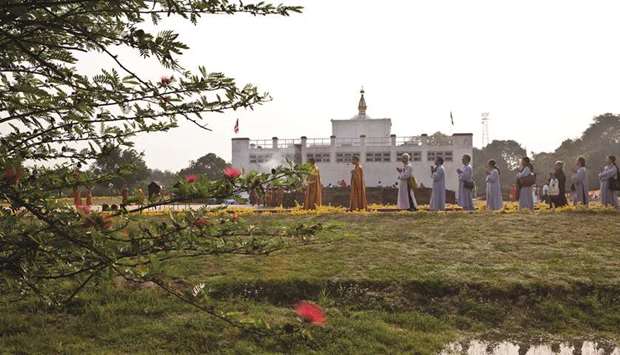Tourists travelling to Nepal generally flip the glossy pages of guide books with captivating mountains on them. These mountains, including the tallest Mount Everest, are located in the northern region of the country. On contrary, the southern region Nepal is a home to lush jungles and national parks with composites of rare flaura and fauna.
Lumbini is one such place in Nepal that holds a great importance in reference to cultural heritage and attract thousands of tourists every season. Lumbini, one of the world’s most important spiritual sites, is home to the historic birthplace of the Buddha. Today you can visit over 25 international Buddhist monasteries, study Buddhism, meditation and visit Buddha’s birthplace itself within the Mayadevi Gardens in Lumbini. The integrity of Lumbini has been achieved by means of preserving the archaeological remains within the property boundary that give the property its Outstanding Universal Value. The significant attributes and elements of the property have been preserved. The buffer zone gives the property a further layer of protection. Further excavations of potential archaeological sites and appropriate protection of the archaeological remains are a high priority for the integrity of the property. The archaeological site beholds a pillar which was built by Maurya emperor, Ashoka, in 3rd Century BC, which was found by Alois Anton Führer, German Indologistm in 1896. There is broad pavilion where one can stroll amidst Buddhist player flags fluttering in the air. Pagoda Shanti Stupa is also present in the city, built by Japanese in the white chalk and located at the height of 1,100 metre. The pagoda monument was built as a symbol of peace and is still known as ‘World Peace Pagoda’.
As Lumbini is central to beautiful architectural details – one can easily see the influence of Thai architecture in various buildings constructed here. Where Cambodian Monastery highlights the architectural influence of Anchor Wat, the largest Hindu temple in the world built for the Khmer Empire, the Chinese Zhong Hua monastery brings Chinese architecture and aesthetics on the table with Confucian avatars guarding it.
The Myanmar Golden Temple highlights the Indo-Chinese heritage. There are many monasteries, including Indian, Nepalese, Sri Lankan, Canadian, Singaporean, French, German, Austrian, South Korean, Vietnamese, and Cambodian existing in the cosmopolitan complex.
Some 30 kilometres west of Lumbini is Tilaurakot, the home of Gautama Buddha where he spent 30 years before escaping from the mundane and everyday lavish life of the palace. He left his wife and a son behind the palace walls as he went to India for meditation. On the bank of Banganga River is the relic of the elaborate palace that has been transformed into the museum with archaeological items on display for the tourists to get an insight into the life of Buddha.
One can visit Lumbini any time of the year. But, Buddha Poornima (Buddha’s full moon) in April or May is the best time to visit Lumbini when hundreds of people from different countries visit the place. One can take a flight from Kathmandu to Bhairahawa, and then a cab, bus or rickshaw to Lumbini. The cheaper option is to take the tourist bus from Kathmandu while enjoying rustic ride with picturesque landscapes. One can simply peddle around Lumbini. There are cost effective accommodation options in Lumbini Bazaar, near to the monastic complex.
Lumbini is a middle-of-a-way spiritual mosaic. You can visit the place while coming from Pokhara, magnificent lakeside on the foothills of Himalaya and, Chitwan National Park, Unesco-listed tiger and rhino shelter. From Lumbini, you can go further west unto lush Bardiya National Park or north to Tansen where a baroque Ranighat Palace, reminiscent of Taj Mahal awaits you on the bank of Kali Gandaki River.

MEDITATION: Today one can visit over 25 international Buddhist monasteries, study Buddhism, meditation and visit Buddha’s birthplace itself within the Mayadevi Gardens in Lumbini.
